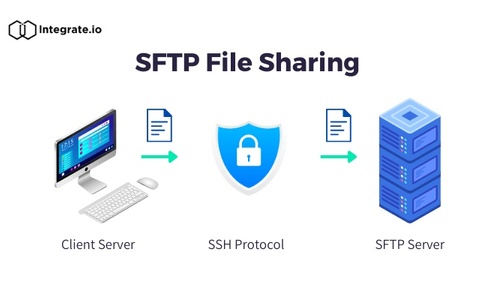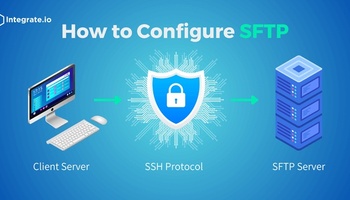- Introduction: What is SFTP
- SFTP vs. FTP: What is The Difference and Which is Better?
- Enhancing Collaboration with Secure SFTP
- Boosting Efficiency through SFTP File Sharing
- SFTP, Security & Compliance: How does it exactly work?
- Best Practices for Successful SFTP Implementation
- SFTP Use Cases
- Future Trends in Secure File Sharing
- Conclusion
Secure FTP (SFTP) is a powerful protocol that businesses can use to improve collaboration, increase efficiency, and safeguard sensitive information. By using SFTP, businesses can securely transfer files between users and locations, regardless of their network or device type. This can help improve productivity and protect sensitive data from unauthorized access. In this article, we’ll discuss what is SFTP, how it works, its benefits, and how to set up SFTP for your business.
The 5 key points discussed in this article are
- SFTP offers impenetrable encryption during file transfers
- Key benefits of using SFTP include seamless collaboration, optimized workflows, and data integrity.
- SFTP uses SSH-based encryption ensuring data integrity and confidentiality.
- Some of the popular SFTP clients include WinSCP, FileZilla, Cyberduck, and SolarWinds
- SFTP best practices include implementing SFTP with firewalls, IP restrictions, and advanced encryption techniques that reinforce security and efficiency.
Introduction: What is SFTP?
Secure File Transfer Protocol (SFTP) is a secure protocol that can be used to transfer files over a secure shell. SFTP file sharing uses encryption to protect the data being transferred, making it a more secure option than traditional FTP. SFTP is a robust solution for file sharing that can help businesses secure data and improve collaboration and efficiency.
- Collaboration: Even if the teams are spread across the world in different locations, SFTP allows the members to send and receive files securely and reliably.
- Efficiency: Creating, uploading, and editing files can be time-consuming for teams. Using SFTP file transfer can enable fast and secure transfer, and businesses can automate file transfers through SFTP, thus improving efficiency.
- Security: SFTP safeguards sensitive information by encrypting the data being transferred. This makes it much more difficult for unauthorized users to access the data.
SFTP vs. FTP: What is The Difference and Which is Better?
Source: http://www.educba.com
The main difference between SFTP and FTP is that SFTP encrypts all data transfers, while FTP does not. This means that with SFTP, your data is protected from unauthorized access even if it is intercepted by a third party.
SFTP also uses a different authentication method than standard FTP. FTP uses usernames and passwords, which can be intercepted by attackers. While SFTP uses public key authentication, which is more secure.
|
Feature |
SFTP |
FTP |
|
Data encryption |
Yes |
No |
|
Authentication method |
SSH |
Username and password |
|
Suitable for |
Sensitive data |
Non-sensitive data |
Further, businesses can also use a Managed File Transfer solution (MFT) which is considered a packaged version of SFTP. MFT solution provides additional capabilities to SFTP like reporting, compliance, enhanced security, and automation.
Key benefits of using SFTP:
- Secure transmission: SFTP encrypts all data transfers, making it much more secure than an FTP server.
- Authentication: SFTP allows for public key authentication of both the server and client side, ensuring only the intended user has access.
- Compatibility: SFTP can be used on any platform that supports Secure Shell like Windows, Linux, and macOS.
- Data Integrity: SFTP file transfer ensures there is no modification of data in transit.
Enhancing Collaboration with Secure SFTP
SFTP can promote seamless collaboration in several ways:
- Secure file sharing: SFTP allows you to share files securely with team members and external stakeholders. This can help reduce communication barriers and delays, as everyone involved can access the files as and when needed.
- Large file sharing: Even when large files are involved, SFTP allows easy transfer, which can be difficult to share with other file-sharing methods. A variety of files including videos, audio files, etc. can be efficiently shared.
- Real-time access: SFTP allows multiple users to access files in real-time. This can help collaborate on documents or projects, as everyone can see the latest changes as they are made in one place.
- Version control: SFTP allows you to track changes to files over time. This ensures that everyone is working on the same version of a file. This also makes reverting to previous versions easy.
- Centralized storage: SFTP allows you to store files in a central location, which makes it easier for team members to find and access the files they need.
- Audit trail: SFTP keeps an audit trail of all file transfers, which can help to track who accessed a file and when.
- Scalability: Even when the number or size of files increases, SFTP can prove to be an efficient solution.
Boosting Efficiency through SFTP File Sharing
SFTP can streamline business processes by providing quick and reliable file sharing. In this section, we’ll discuss some of the advantages of SFTP like reduced downtime, improved workflows, and how it helps in improving efficiency.
-
Streamlined File Sharing: Traditional methods of sharing files, such as email attachments or other cloud solutions often introduce bottlenecks and risks. Secure SFTP eliminates these concerns by providing a reliable channel for transferring files. The data is safeguarded during transit, ensuring that sensitive information remains confidential.
-
Impact on Reduced Downtime, Improved Workflows, and Faster Decision-Making: Large file uploads can take longer time when using traditional file-sharing methods. But using SFTP, this can be accomplished quickly, eliminating unnecessary delays in project timelines. This allows teams and developers to stay on track, and avoid any blockers. Furthermore, the collaborative nature of SFTP fosters improved workflows. SFTP allows team members to exchange documents, revisions, and updates seamlessly. This exchange eliminates manual handoffs, improving the workflow. Since stakeholders have real-time access to the latest information, this ensures faster decision-making.
-
Automated Features: Scheduled Transfers and Notifications: Scheduled transfers allow businesses to program file transfers as and when most suitable. This reduces network resource utilization and optimizes the data flow. This not only prevents congestion but also ensures that critical tasks are not affected by large file transfers. Notifications improve efficiency by keeping stakeholders informed throughout the file-sharing process. Users can receive alerts when files are successfully uploaded or downloaded, eliminating the need for manual follow-ups and confirming that tasks are completed.
SFTP & Security: How does it exactly work?
If you’ve read so far, you understand the capabilities and benefits of using SFTP. But in the background, how does it work? In this section, let’s talk about safeguarding sensitive information with SFTP.
-
Data Security: Unlike conventional file-sharing methods that can leave information vulnerable during transit, SFTP uses the robust encryption provided by the Secure Shell (SSH) protocol. This ensures that data is protected from unauthorized access during transfer, making it an invaluable asset for businesses dealing with sensitive data like customer information.
-
Encryption Methods in SFTP: SFTP employs encryption (Secure Shell) serving as the bedrock. SFTP operates on port 22 and uses SSH to ensure secure connection and data encryption.
The GDPR mandates businesses to ensure the protection of personal data of EU citizens and residents, especially when transferring it outside the European Union. Using secure methods like SFTP, which employs SSH-based encryption, can help businesses safeguard data during such transfers. Additionally, maintaining a log of the files being transferred can assist in compliance, as GDPR emphasizes transparency and accountability in data processing activities.
Best Practices for Successful SFTP Implementation
Now that we’ve walked through the Whys and Hows of SFTP implementation, it is important to follow some of the best practices to ensure the process remains secure and efficient. Below are a few of the best practices that can be followed:
- Firewalls: Ensure your SFTP setup uses a dedicated firewall to prevent unauthorized parties from accessing. The firewalls create a Virtual Private Data Center which allows only the specified users to have access.
- IP Address Restrictions: To introduce a strict level of security, you can consider restricting access to the files for specific IP Addresses. Any other IP will not be able to access the files.
Future Trends in Secure File Sharing
The digital landscape is evolving at its fastest pace and with it increases the requirement to keep data secure and establish privacy. There is notable development and progress on the data encryption front as we evolve technologically. More secure and sophisticated encryption algorithms are being developed which ensure data remains shielded from cyber threats and hackers.
On the file-sharing front, with the rise of remote work, the importance of secure file-sharing has skyrocketed. Now the teams operate over diverse geographical locations, and the data being exchanged needs to remain secure and encrypted.
Amid these changes and the constant requirement for standard encryption measures, file-sharing methods like SFTP prove to be efficient time and again. SFTP is a mature protocol and is likely to continue to evolve to meet the changing demands of modern businesses.
Conclusion
With digital advancement at its peak, the need for secure and reliable data exchange methods keeps increasing. In this article, we discussed how SFTP can be a useful tool to deal with the requirements. A quick recap on the significance of SFTP and the points discussed:
- Robust Security: SFTP offers encryption during the file transfer process, securing data against unauthorized access and breaches.
- Efficiency: SFTP's swift and reliable file sharing boosts efficiency by minimizing downtime, streamlining workflows, and facilitating faster decision-making.
- Seamless Collaboration: SFTP enables secure real-time sharing and editing of files, fostering seamless collaboration across teams.
- SSH-based Encryption: SFTP employs the Secure Shell (SSH) protocol for encryption, ensuring data integrity and confidentiality.
- Best Practices: Implementing SFTP with firewalls, IP restrictions, and advanced encryption techniques reinforces security and efficiency.
Considering the above benefits and capabilities of SFTP, it is worth considering as a reliable solution for fulfilling file-sharing requirements.
How Integrate.io Can Help with SFTP
Integrate.io is a cloud-based data integration and migration tool that provides a rich set of features. Integrate.io provides 100+ built-in connectors including SFTP which allows quick, easy, and secure data integration. Its drag-and-drop user interface allows even non-technical users to leverage cloud capabilities.
Leveraging SFTP along with Integrate.io can prove to be a killer combination for your business. Get in touch with our team of data experts to discuss your business requirements or sign-up for a 14-day free trial today to experience the magic firsthand.
Related: Allowing Integrate.io access to my data on Secure File Transfer Protocol (SFTP)











